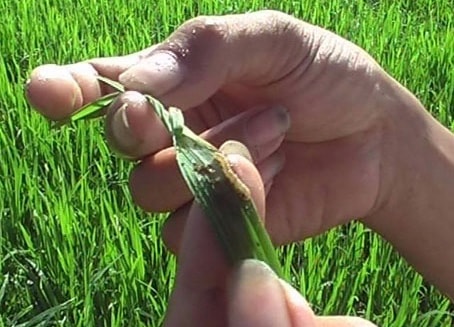Control of leaf rollers
Recently, due to complicated weather conditions and prolonged hot weather, the 2014 winter-spring rice crop in Nghe An and Ha Tinh has been damaged by the leaf roller (SCLN).
 |
| Rice leaf roller |
In Nghe An, there are 9,500 hectares infected with SCLN, of which 1,500 hectares are heavily infected, concentrated in the districts of Yen Thanh, Dien Chau, Do Luong, Thanh Chuong, Quynh Luu, Hung Nguyen. SCLN generation 3 causes damage with a common density of 20 - 50 individuals/m2, in high places 100 - 150 individuals/m2, in some cases 200 - 250 individuals/m2, currently the worms are mainly at the age of 3 - 5.
It is expected that the 3rd generation of SCLN adults will emerge from July 7 to 12, and the 1st and 2nd instar larvae of the 4th generation will emerge from July 14 to 20. In addition, the current density of brown planthoppers and white-backed planthoppers is from 20 to 50 individuals/m2 in some places, 300 to 500 individuals/m2, and it is forecasted that in the coming time, planthoppers will continue to arise and cause damage.
In Ha Tinh, as of June 25, the entire province had 2,382 hectares of rice infected with SCLN, of which Can Loc district had 925 hectares, Duc Tho district had 500 hectares, Thach Ha district had 250 hectares, Hong Linh district had 210 hectares, Ha Tinh city had 280 hectares...
The common density of worms is from 30 - 50 individuals/m2, in high places 70 - 100 individuals/m2, in some cases 150 - 250 individuals/m2, the development rate of 1st instar larvae is 20%, 2nd instar larvae is 70%, 3rd instar larvae is 10%. Weather and crop conditions are favorable for the development of worms and there is a risk of widespread epidemics.
In the North Central region, since the SCLN pandemic of the 2010 winter-spring crop, the source of worms has accumulated more and more and often appears right from the beginning of the crop.
In which, SCLN damage at the stage when rice plants finish tillering - forming panicles (4th batch in Nghe An) is very important, deciding the success or failure of the crop, because at this stage, if any leaf is lost, that leaf is lost forever because when the rice plant has formed panicles, it no longer has the ability to recover if damaged by SCLN because it cannot grow more leaves.
On the other hand, with the current density trend as above, the next generation of worms is at risk of high and very high density, increasing exponentially.
Usually, SCLN prevention by farmers in many places across the country, not just in the North Central region, is often not very effective, due to subjectivity as well as limitations in plant protection knowledge.
In addition to the habit of late prevention, spraying only when the leaves are white (age 3 - 5), a common misconception among farmers is that using non-selective pesticides at the tillering stage reduces the density of natural enemies and using contact pesticides when the worms have entered the nest or have rolled up the nest themselves (age 2 - 3).
Therefore, to accurately determine the time of treatment when the density reaches the threshold of economic damage, farmers must master the following knowledge: SCLN life cycle lasts from 25 - 30 days, depending on the environmental temperature. With temperatures above 30 degrees Celsius, the life cycle can be shortened to 22 - 25 days.
After seeing adults appear in large numbers in the field, after 3-4 days there will be 1st instar larvae. Larvae will go through 5 instars (4 molts), each instar lasts about 3 days, meaning after seeing adults appear in large numbers, after 3-7 days is the most appropriate time for prevention.
If the date of the previous generation can be determined, the next generation will appear 25 - 30 days later. If the worms are found at the tillering stage when the leaves have turned white, then prevention should not be done anymore. Prevention after 2 weeks is most appropriate, because that is the first age of the next generation.
Treatment should be done at the 1st - 2nd instar stage. When the worms are older, prevention will not be effective because at that time the worms have entered the nest or spun silk to wrap the nest, the medicine will not be able to contact the worms. On the other hand, when the worms are 3rd - 4th instar, the rice leaves are basically white, all the leaf flesh is lost, only the leaf veins remain, so even systemic drugs cannot be absorbed and circulated.
When the worm reaches age 4-5, the chitin layer on its body becomes thicker, reducing its ability to adhere and absorb medicine. At age 5, the worm basically stops eating, so when medicine acts through the digestive tract, it is not effective.
SCLN control drugs include two main lines: contact and systemic. If using contact lines such as Ebamectin benzoate (Proclaim 1.9EC), Lamda-cyhalothrin (Karate 2.5EC)..., spray when the worms first appear. If using systemic lines such as Chloratraniliprole (Voliam Targo 063SC, Virtako 40WG), spray immediately when adults emerge, or from after adults emerge until the 3rd instar larvae. For areas with additional pressure from leafhoppers, Virtako 40WG should be used. For areas with additional pressure from spider mites, Voliam Targo 063SC should be used to save costs on preventing leafhoppers and spider mites.
Optimal recommended dosage: Virtako 40WG from 60-75 grams/ha, Voliam Targo 063SC from 0.4 - 0.6 liters/ha, Proclaim 1.9EC from 0.15 - 0.2 liters/ha, Karate 2.5EC from 0.4 - 0.5 liters/ha. The amount of water sprayed must be 400 - 500 liters/ha.
According to Agriculture






